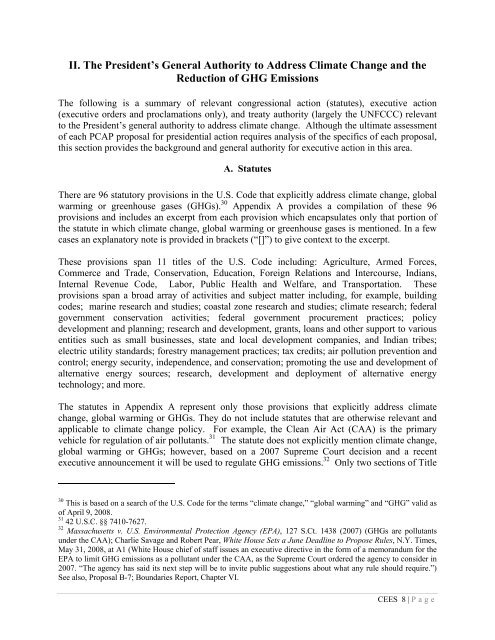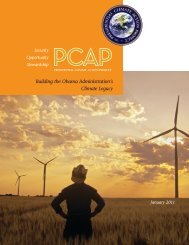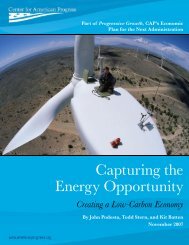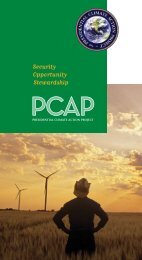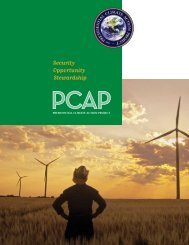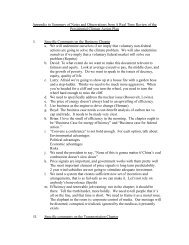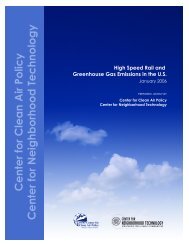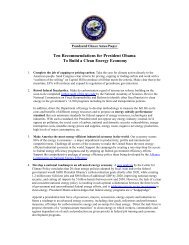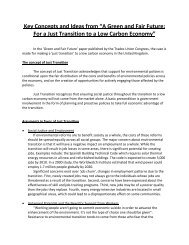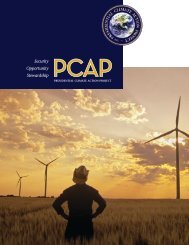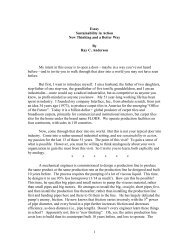PCAP - Presidential Climate Action Project
PCAP - Presidential Climate Action Project
PCAP - Presidential Climate Action Project
- No tags were found...
You also want an ePaper? Increase the reach of your titles
YUMPU automatically turns print PDFs into web optimized ePapers that Google loves.
II. The President’s General Authority to Address <strong>Climate</strong> Change and theReduction of GHG EmissionsThe following is a summary of relevant congressional action (statutes), executive action(executive orders and proclamations only), and treaty authority (largely the UNFCCC) relevantto the President’s general authority to address climate change. Although the ultimate assessmentof each <strong>PCAP</strong> proposal for presidential action requires analysis of the specifics of each proposal,this section provides the background and general authority for executive action in this area.A. StatutesThere are 96 statutory provisions in the U.S. Code that explicitly address climate change, globalwarming or greenhouse gases (GHGs). 30 Appendix A provides a compilation of these 96provisions and includes an excerpt from each provision which encapsulates only that portion ofthe statute in which climate change, global warming or greenhouse gases is mentioned. In a fewcases an explanatory note is provided in brackets (“[]”) to give context to the excerpt.These provisions span 11 titles of the U.S. Code including: Agriculture, Armed Forces,Commerce and Trade, Conservation, Education, Foreign Relations and Intercourse, Indians,Internal Revenue Code, Labor, Public Health and Welfare, and Transportation. Theseprovisions span a broad array of activities and subject matter including, for example, buildingcodes; marine research and studies; coastal zone research and studies; climate research; federalgovernment conservation activities; federal government procurement practices; policydevelopment and planning; research and development, grants, loans and other support to variousentities such as small businesses, state and local development companies, and Indian tribes;electric utility standards; forestry management practices; tax credits; air pollution prevention andcontrol; energy security, independence, and conservation; promoting the use and development ofalternative energy sources; research, development and deployment of alternative energytechnology; and more.The statutes in Appendix A represent only those provisions that explicitly address climatechange, global warming or GHGs. They do not include statutes that are otherwise relevant andapplicable to climate change policy. For example, the Clean Air Act (CAA) is the primaryvehicle for regulation of air pollutants. 31 The statute does not explicitly mention climate change,global warming or GHGs; however, based on a 2007 Supreme Court decision and a recentexecutive announcement it will be used to regulate GHG emissions. 32 Only two sections of Title30 This is based on a search of the U.S. Code for the terms “climate change,” “global warming” and “GHG” valid asof April 9, 2008.31 42 U.S.C. §§ 7410-7627.32 Massachusetts v. U.S. Environmental Protection Agency (EPA), 127 S.Ct. 1438 (2007) (GHGs are pollutantsunder the CAA); Charlie Savage and Robert Pear, White House Sets a June Deadline to Propose Rules, N.Y. Times,May 31, 2008, at A1 (White House chief of staff issues an executive directive in the form of a memorandum for theEPA to limit GHG emissions as a pollutant under the CAA, as the Supreme Court ordered the agency to consider in2007. “The agency has said its next step will be to invite public suggestions about what any rule should require.”)See also, Proposal B-7; Boundaries Report, Chapter VI.CEES 8 | P age


